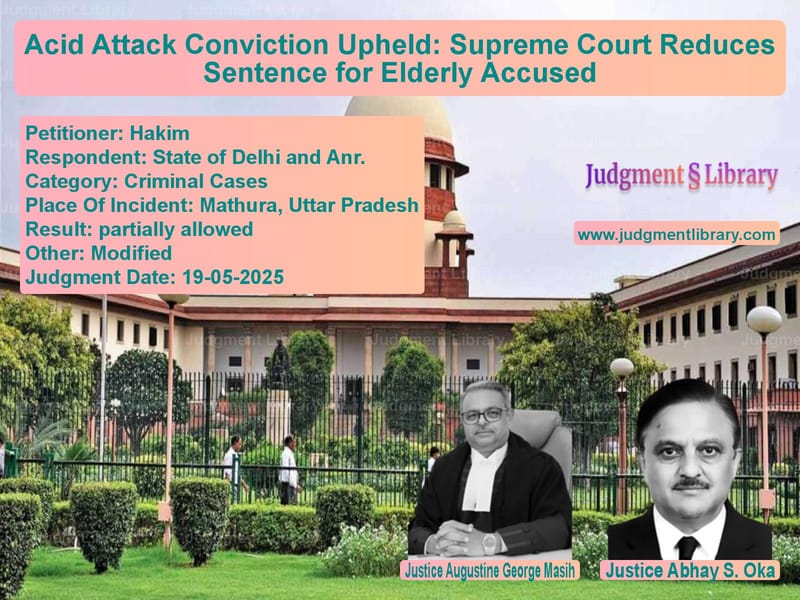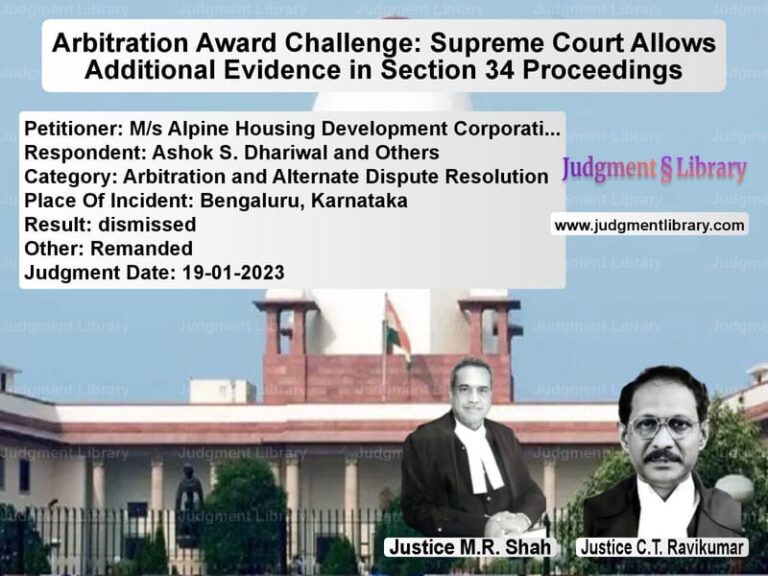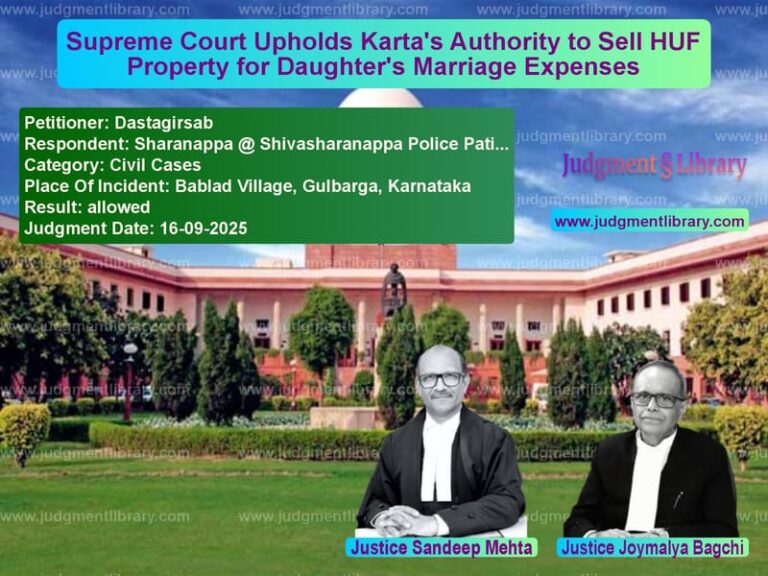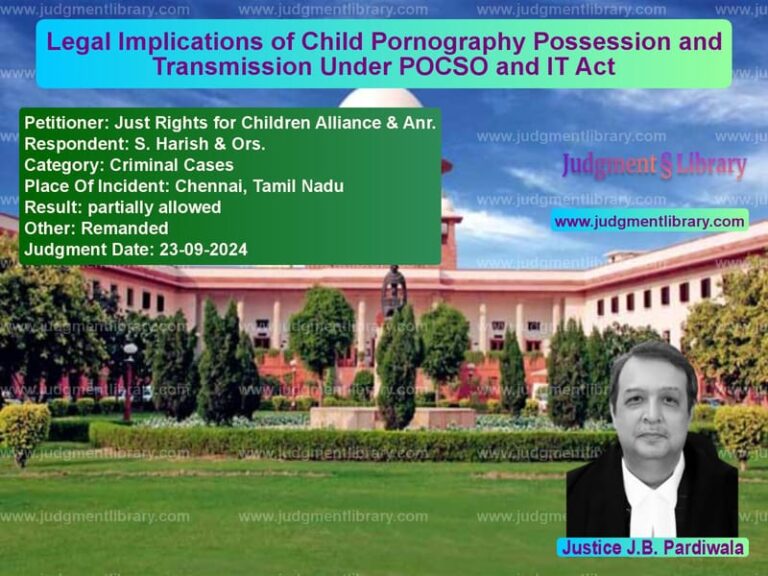Acid Attack Conviction Upheld: Supreme Court Reduces Sentence for Elderly Accused
In a significant ruling that balances the severity of acid attack crimes with considerations of age and health, the Supreme Court of India recently delivered a nuanced judgment in a harrowing case that left a woman permanently disfigured and partially blind. The case involving Hakim and Umesh versus the State of Delhi represents one of the most serious categories of violent crimes in contemporary India – acid attacks that not only cause physical devastation but leave deep psychological scars on victims. This judgment demonstrates the judiciary’s careful approach to criminal appeals, where established convictions are scrutinized against legal principles while also considering humanitarian aspects during sentencing.
The tragic incident that led to this legal battle occurred on the evening of June 8, 2014, when the victim was returning home after visiting the Galteshwar Mahadev temple in Mathura, Uttar Pradesh. According to the prosecution’s case, the victim was accompanied by her sister-in-law, Rajjo Devi, who was walking a few steps behind her. As they approached the Govind Nagar railway crossing, the two appellants – Hakim and Umesh – along with a third accused named Gyani, blocked the victim’s path. The assailants allegedly told her that she would face consequences for having filed a complaint against them with police authorities earlier. What followed was a brutal attack that would change the victim’s life forever.
The prosecution alleged that Hakim (Accused No. 1) and Gyani (Accused No. 3) held the victim while Umesh (Accused No. 2) poured acid over her. The attackers then fled the scene, leaving the victim screaming in agony. Rajjo Devi, who witnessed the attack from a short distance, rushed to help and took the victim to the hospital for emergency treatment. The subsequent investigation revealed that all the accused were neighbors of the victim in Laxmi Nagar, falling under the jurisdiction of Krishna Nagar Police Chowki of Kotwali Police Station, Mathura, and were known to each other prior to the incident.
Read also: https://judgmentlibrary.com/supreme-court-cancels-bail-in-murder-case-land-dispute-turns-deadly/
The legal proceedings began with the registration of FIR No. 130 of 2014 at Govind Nagar Police Station, Mathura, based on a written complaint by Bablu, the victim’s husband. After recording statements from the victim and eyewitness Rajjo Devi, the Investigating Officer completed the investigation and filed a final report under Section 173 of the Code of Criminal Procedure. The case was initially set for trial before the District and Sessions Court in Mathura for offences under Section 326A read with Section 34 of the Indian Penal Code, which deals with voluntarily causing grievous hurt by use of acid and acts done by several persons in furtherance of common intention.
During the pendency of the trial, the case was transferred to Delhi on the complainant’s request, and the Supreme Court allowed the transfer petition on September 1, 2015. The trial proceeded with the prosecution examining 14 witnesses, recording statements of the accused under Section 313 of CrPC, and the defense producing 3 witnesses. The Trial Court convicted all three accused and sentenced Hakim and Umesh to rigorous imprisonment for life with a fine of Rs. 1,00,000 each, while Gyani received a sentence of 10 years rigorous imprisonment with a fine of Rs. 50,000.
All three convicts appealed to the Delhi High Court, which affirmed the convictions but reduced Gyani’s sentence to 10 years while maintaining the life imprisonment for Hakim and Umesh. The High Court also observed that the victim deserved compensation of at least Rs. 5,00,000, with the balance amount (after what was received from the convicts) to be borne by the State of Uttar Pradesh under the Uttar Pradesh Victim Compensation Scheme, 2014.
Hakim and Umesh then approached the Supreme Court through special leave petitions. Initially, the Supreme Court issued notice only on the quantum of sentence, but as proceedings progressed and the appellants appeared to dispute the injuries caused to the victim, the court granted leave to appeal on all aspects.
Before delving into the specific arguments in the case, the Supreme Court carefully outlined the jurisprudential principles governing its interference in criminal appeals arising from special leave petitions where concurrent findings have been returned by lower courts. The court referenced its landmark decision in Mst Dalbir Kaur and Others v. State of Punjab, which reiterated that the Supreme Court would interfere only when exceptional and special circumstances exist, resulting in substantial and grave injustice to the accused. The court summarized the governing principles as follows: “(1) it does not interfere with concurrent findings based solely on evidence appreciation, even if another view is possible; (2) it avoids reappraisal unless there’s legal or procedural error, misreading or inconsistency in evidence, e.g., clear contradiction between ocular and medical evidence; (3) it refrains from re-evaluating credibility of witnesses; (4) interference occurs where judicial process or natural justice is violated, causing prejudice; (5) it intervenes if findings are perverse or based on no evidence.”
The court further strengthened this jurisprudential foundation by referencing Bharwada Bhoginbhai Hirjibhai v. State of Gujarat, which held that “a concurrent finding of fact cannot be reopened in an appeal by special leave unless it is shown that the finding is based on no evidence; or that it is perverse, being such that no reasonable person could have arrived at, even if, the evidence is taken at face value; or that the finding is founded on inadmissible evidence which, if excluded, would negate or seriously impair the prosecution case; or that vital evidence favouring the convict has been overlooked, disregarded, or wrongly discarded.”
With these guiding principles established, the Supreme Court turned to the specific arguments presented by the learned Senior Advocate representing the appellants. The counsel pressed that “they have been falsely implicated and that the prosecution has failed to prove the ingredients so as to attract the offence under Section 326A IPC 1860.” To buttress this argument, he submitted that “there is no claim of eye injury in the FIR or the statement of the Respondent-Victim or the medical record. Thereby, the prosecution has failed to establish that the claimed eye injury was result of pouring of acid on the Respondent-Victim by Accused No.2. Rather, reference to multiple hospitals by the Respondent-Victim was an attempt to obtain a suitable medical report with respect to the eye injury.”
The counsel further contended that “in order to prove the claim that an acid or a chemical was poured on the Respondent-Victim, the prosecution was to show the source of procurement of the said substance, which it failed. In such a situation, the conviction under Section 326A IPC 1860 is unsustainable in law. Alleged burns could, therefore, be caused by hot water.”
Regarding procedural lapses, the Senior Advocate argued that “there is an inordinate delay of 11 days in recording statements of witnesses PW-4 and PW-6, creating a serious doubt” and that “in the site plan prepared at the instance of PW-4, the presence of PW-6 is not indicated, therefore she is not an eye-witness.” He also challenged the investigation standards, stating that “the observation to the effect that the Investigating Officer was not bound to follow the Standard Operating Procedure prescribing detailed methodology vis-a-vis an acid attack case is not good in law.”
For Hakim specifically, the counsel emphasized that “Accused No.1 is a army personnel, aged above 70 years, and it is improbable for him to having been an accomplice in the said act.”
The Supreme Court systematically addressed each of these arguments within the constrained jurisdictional boundaries it had earlier outlined. Regarding the eye injury and its causation, the court noted that “As per the evidence led by the prosecution, different Doctors appeared as prosecution witnesses who had treated the victim on various occasions i.e., PW-5, PW-8, PW-9, PW-10, PW-11, PW-12 and PW-14. All of them have testified that the injuries on the skin and the deformity of the face, including loss of vision, albeit not fully i.e., 90% in the left eye of the Respondent-Victim were the result of serious Chemical Burn injuries.” The court also noted that “Prosecution has produced and proved the photograph on the Aadhaar Card of the Respondent-Victim where it is reflected that she had normal eyes and face.”
On the question of proving the nature of the substance used, the court observed that “The question of the nature and contents of the alleged substance used and thrown on the victim would not arise as the possibility of recovery of the same does not arise as the incident was committed at railway crossing adjacent to the railway line where all the accused ran away after committing the offence. However, chemical burns on the person of the Respondent-Victim are substantiated from testimonies and medical evidence as referred to above.”
The delay in recording witness statements was explained by the court, noting that “their family was under constant threat because of which all had to leave Mathura to save and protect themselves apart from the aspect of medical treatment of the victim. The fact that the statements were recorded immediately on their return to Mathura by the police is substantiated.”
Regarding the credibility of the eyewitness, the court found that “she was merely 10 paces away from the site of occurrence and thus was well positioned not only to hear the conversation but also to witness the specific act and role of the Appellants and third accused accosting and assaulting the Respondent-Victim before they ran away from the spot.”
The court dismissed the argument about Standard Operating Procedures, stating that “the same are procedural guidelines and not mandatory. The prosecution has followed due procedure and measures in the investigation.”
On Hakim’s advanced age and background as an army personnel, the court observed that “the age has no bearing on the crime. Even further, the Appellant had regularly been appearing before the Trial Court when it was observed that he was maintaining good health then. The plea of improbability has no legal force in the presence of eye-witnesses and their testimony.”
Having thus rejected all challenges to the conviction, the Supreme Court upheld the findings of both lower courts, stating that “the view that the guilt of both, Accused No.1 and Accused No.2, has been proved beyond reasonable doubt is not only a plausible one but established. Hence, we are not inclined to interfere.”
The court then turned to the question of sentence, where the Senior Counsel for the appellants pleaded for leniency. For Hakim specifically, the counsel pleaded for parity with Accused No. 3 (Gyani), who had received a 10-year sentence instead of life imprisonment. The counsel referenced medical records showing that “he is about 73 years old and even the Senior Medical Officer of Central Jail, Tihar has mentioned for the Appellant to be considered as ‘seriously sick patient’ on 24.07.2023. He has multiple ailments, namely, anaemia, PSVT, CAD, Bronchial Asthma, Hypertension, BPH, CKD state-IV, and Epididymo-orchitis with LUTS and therefore, we are conscious of the said fact.”
The Supreme Court showed judicial compassion in this aspect, noting that “Therefore, considering the role in the offence, age and ailments being suffered by the Appellant- Accused No.1, we are inclined to interfere and reduce the sentence and bring it at par with the sentence awarded to the Accused No.3 for his role in holding the Respondent-Victim. The Appellant-Accused No.1 (Hakim) is, thus, sentenced to rigorous imprisonment for 10 years along with fine of INR 50,000/- and in default or non-payment of the said fine, simple imprisonment for six months.”
However, for Umesh, who had actually poured the acid, the court took a stricter view, observing that “being an advocate, he was not only well-read in law but owed a duty to the court being its officer requiring him to conduct with dignity, respect law and fellow beings. Having let down the community as a whole, we are not inclined to interfere with the sentence awarded to him.”
Thus, while upholding both convictions, the Supreme Court partly allowed Hakim’s appeal by reducing his sentence to 10 years while dismissing Umesh’s appeal and maintaining his life imprisonment. This nuanced approach demonstrates the judiciary’s ability to balance the demands of justice with considerations of individual circumstances, while maintaining the severity of punishment for the principal perpetrator of this heinous crime.
Petitioner Name: Hakim.Respondent Name: State of Delhi and Anr..Judgment By: Justice Augustine George Masih, Justice Abhay S. Oka.Place Of Incident: Mathura, Uttar Pradesh.Judgment Date: 19-05-2025.Result: partially allowed.
Don’t miss out on the full details! Download the complete judgment in PDF format below and gain valuable insights instantly!
Download Judgment: hakim-vs-state-of-delhi-and-a-supreme-court-of-india-judgment-dated-19-05-2025.pdf
Directly Download Judgment: Directly download this Judgment
See all petitions in Attempt to Murder Cases
See all petitions in Extortion and Blackmail
See all petitions in Custodial Deaths and Police Misconduct
See all petitions in SC/ST Act Case
See all petitions in Judgment by Augustine George Masih
See all petitions in Judgment by Abhay S. Oka
See all petitions in partially allowed
See all petitions in Modified
See all petitions in supreme court of India judgments May 2025
See all petitions in 2025 judgments
See all posts in Criminal Cases Category
See all allowed petitions in Criminal Cases Category
See all Dismissed petitions in Criminal Cases Category
See all partially allowed petitions in Criminal Cases Category







